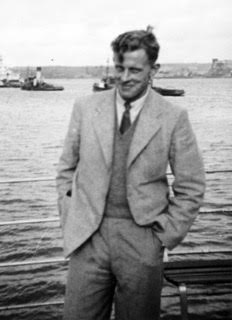Stories from Southlands Hotel, by Iris Ansell: 7.i. Budleigh’s ‘Cherry Ripe’
Pictured above is Budleigh resident Iris Ansell next to a celebrated painting by Sir John Everett Millais. As a volunteer at Fairlynch Museum Iris looked after the Costume Department. In this article she
recalls more memorable moments from her time as proprietor of Southlands Hotel
in Budleigh Salterton. The article is the seventh in a series of her
recollections Image credit: 'Cherry Ripe' Wikipedia
Most local people know that Sir John Everett Millais came to Budleigh in 1870 to paint ‘The Boyhood of Raleigh’. Here Iris writes of the extraordinary and largely unknown story of a second link between Budleigh and the celebrated Pre-Raphaelite artist. I have mixed my own thoughts and research with Iris’s story.
Iris’ previous story ‘The Wrong Emmanuel’ was told here
Top: Southlands Hotel on Budleigh's Marine Parade was replaced by Marine Court's apartments
But here’s her latest story to appear on ‘Budleigh
– Past and Present’:
‘In the late 1970s and 80s, my late husband and I owned and ran a hotel – The Southlands Hotel – on Budleigh Salterton’s Marine Parade, where Marine Court is now,’ Iris explains.
Reproductions of ‘Cherry Ripe’ were immensely popular, including versions in tapestry and jigsaw, currently advertised on Ebay. The 1880 Christmas edition of The Graphic, featuring a print of Cherry Ripe, sold 500,000 copies
‘One day a couple booked in for a night as they
were attending the husband’s mother’s 100th birthday lunch at a
nursing home in the town. At about 8.00 pm they returned, and came into the
bar. It was a winter’s night and I was doing a tapestry of Millais’ ‘Cherry
Ripe’. The man put his hand on my shoulder and said, ‘That’s my mother’. He
began to tell me the story.’
Now the identity of the girl who modelled for ‘Cherry Ripe’ is no mystery. The painting was well known from a series of young sitters whom Millais painted between 1860 and 1880.
An 1873 front page of The Graphic with its founder William Luson Thomas (1830-1900) as caricatured by Spy (Leslie Ward) in Vanity Fair, December 1894 Image credit: Wikipedia
The generally accepted story about the origin of Millais’ painting is that a fancy dress ball was hosted in 1879 by The Graphic, an influential art journal of the time. Among the guests was Edie Ramage, the young niece of the magazine’s editor and founder William Luson Thomas who was a friend both of Millais and of leading society figures of the time such as Dickens.
Sir Joshua Reynolds (1723-92) PRA, FRS, FRSA
and his portrait of Penelope Booth. The
child died in 1791 aged five. Image
credit: Wikipedia
Edie wore a costume inspired by Sir Joshua Reynolds's celebrated
1788 portrait of Penelope Boothby, the three-year-old daughter
of the Derbyshire translator and poet Sir Brooke Boothby. She was so much
admired at the ball that the following morning she was again dressed as the Penelope
Boothby character and was carried off to Millais’ studio. The artist was so
delighted with his little model that it was agreed upon the spot that he should
paint her portrait.
But the Southlands Hotel hotel guest, having claimed Edie Ramage as his mother, told Iris a different story about the origin of the painting. It may or may not be true, she admits.
The Octagon on Fore Street, Budleigh
Salterton, with an 1881 self-portrait of Sir John Everett Millais (1829-96) PRA Image credit: Wikipedia
According to the guest’s account, his mother
was about four years old and on holiday with her parents – in Budleigh Salterton!
The key point of his story was that
Millais was ‘painting in his studio in The Octagon’ when he saw Edie Ramage
come by with her nursemaid and asked if he could paint her.
‘The Boyhood of Raleigh’ by Millais, with
the blue plaque on Budleigh’s Raleigh Wall
Most people would say that obviously a bit of
confusion had arisen here, with the story of Millais’ 1870 stay at The Octagon,
next to what is now Fairlynch Museum, during the painting of ‘The Boyhood of
Raleigh’.
But does the hotel guest’s account have any truth in it? Edie apparently told her son that she hated the painting, and had cried most of the time while she was sitting as a model. ‘Indeed one can see the tears in the painting,’ the guest told Iris.
Well, it’s a good story, even if the painting is seen today as horribly sentimental, or ‘a revolting piece of saccharine commercialism’ as art historian Kirsty Stonell Walker calls it! Whatever Edie Ramage thought about her portrayal as ‘Cherry Ripe’, there’s no doubt that it contributed greatly in establishing Millais as the most successful painter of his generation.
As his son John Guille Millais wrote, ‘Thanks to the engraver’s and woodcutter’s art, ‘Cherry Ripe’ found its way into the remotest parts of the English-speaking world, and everywhere that sweet presentment of English Childhood won the hearts of the people. From Australian miners, Canadian backwoodsmen, South African treckers, and all sorts and conditions of colonial residents, came to the artist letters of the warmest congratulation, some of which stirred his heart by the deep emotion it expressed.’
In spite of its initial popularity ‘Cherry Ripe’ has been out of sight for much of its life. The painting was first exhibited in London in 1881, and was later displayed in the British section of the 1898 Exposition Internationale in Paris. It returned to London that year for a Millais Memorial Exhibition.
Continued at
https://budleighpastandpresent.blogspot.com/2021/02/stories-from-southlands-hotel-by-iris_28.html










Comments
Post a Comment